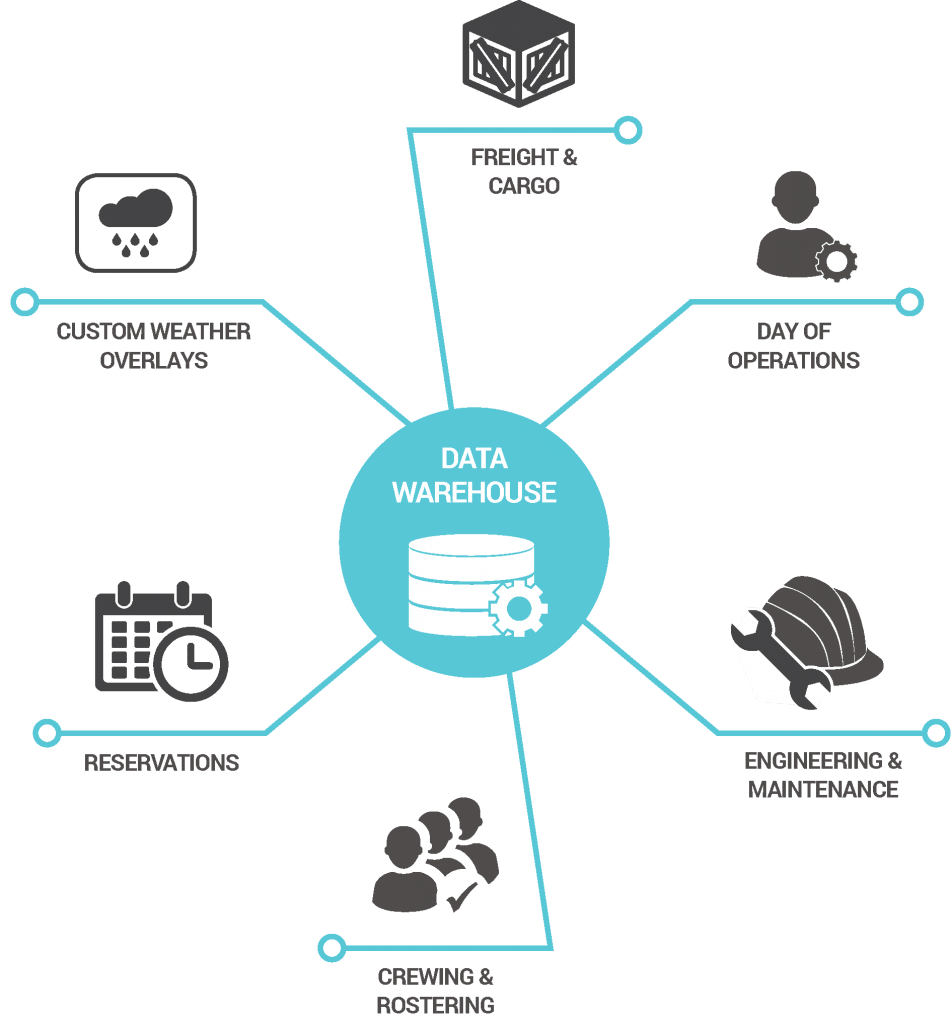It is one of the most pressing problems in the aviation industry: every aspect of operating an aircraft fleet efficiently is governed by a system, which means there are a lot of systems to monitor, coordinate and manage.
Moreover, keeping on top of all those disparate systems across various departments, regulations and operational priorities becomes increasingly complicated the more tails you have.
There are just so many moving parts, so much compliance, so many people involved and so little time. But there is a way to make flying simple again. It’s called cross data integration, or XDI.
What is Cross Data Integration? (XDI)
Think of XDI as an enabling technology. It brings management, operations, pilots, HR, customer service and engineering all onto the same page. In giving them a view using data from other networked systems company-wide, these departments can make their business decisions from the best possible vantage point.
Traditionally, in aviation (and any other complicated knowledge-intensive industry) different departments within an organisation don’t “speak the same language” and, as a whole, face considerable reporting lags. The result is operations that can’t harness operational knowledge in real time. These days are over.
The role of Cross Data Integration for managers
Although they may not think of it in such terms, a large part of the role of senior managers globally is to interpret a stream of tactical data from isolated organisational silos to make broader strategic decisions.
At first, this seems natural, which is why some operators don’t quite grasp the power of XDI. However, what XDI really does is collate those sources of disparate data into real-time tactical data.
While large airlines already have dedicated analysts within their operations department that perform this function, mid-tier operators typically do not. Instead, for their 10 or 20 or 50 tails, they can be stuck with suboptimal systems to monitor engineering, project management, managed comms, flight records and so on.
Often, if you drill down through the tangle of these systems, you’ll see that what is really keeping the aircraft in the sky and the cash flow rolling is a nest of Excel spreadsheets.
Using the SkyNet XDI platform, these operators can instead have a single dashboard fed with all the relevant data to give them a complete visual overview of their airline, operation or fleet. And it does not require a special analyst to deploy, monitor and use.
Cross Data Integration (XDI) reaches across the silos
SkyNet XDI can accommodate data feeds from various disparate and siloed systems for functions such as:
- Freight and cargo – including weights, hazardous materials, delivery to terminal and ETAs
- Crewing – including rosters, fatigue, training, availability and scheduled hours
- Reservations – including e-ticketing, flight manifests, passenger manifests and weight distribution
- Engineering – including maintenance tracking, compliance, service cycles and minimum equipment lists
- Custom weather overlays sourced from the online services
- Internet of Things (IoT) – tracking all the physical terminal and tarmac assets, plus analytics on the interlocking procedures that go into getting an aircraft safely off the ground.
As operators currently monitor the above in so many different ways, SkyNet XDI was developed to integrate everything from best-of-breed systems down to ad-hoc spreadsheets. It can even work with paper-based logs.

Deploying and using XDI is easier than you think
As a RESTful API, SkyNet XDI can be viewed through virtually any device with web access and a browser. The result is a solution that is scalable, secure and has extremely high uptime.
An important point to note is that SkyNet XDI does not replace your systems. Rather, it unifies their output into a single, powerful, clear and simple dashboard.
As it is so flexible and usually requires little configuration, adopting SkyNet XDI is simpler than it seems. How the solution works for different categories of aircraft operator or air services providers really comes down to what sorts of data they need to integrate.
Some examples:
- A small charter company may not need to integrate cargo data
- A regular public transport operator may want to control the visibility of contracts
- The air services division of a resources company may not need rostering.
While no two SkyNet XDI customers need to integrate the same systems, there are some systems that are used more frequently. Thus, implementing XDI for many customers means integrating systems data from partners SkyNet already works with.
XDI and data warehousing
In its fullest implementations, the solution works seamlessly with complex proprietary data warehouses to extract business intelligence, reporting, analytics and forecasts into how your organisation is operating now and moving forward.
It also contains a historical log of everything your aircraft have ever done, thus becoming a crucial tool in compliance, auditing and reporting. If CASA or the FAA or any other air services regulator asks, you have the information they want immediately on hand.
Simply, through SkyNet XDI your organisation can master its:
- Past – through tracking all historical data
- Present – through monitoring your operations in real time
- Future – through giving you the data your need for forecasts.
XDI makes flying simple again
When operators use SkyNet XDI to finally get some simple clarity in all the systems they manage, they soon find the solution becomes the operational cornerstone of their airline. One they didn’t even know they needed.
They find that SkyNet XDI gives them efficiency and visibility of where they are and the business insights to make improvements and operational enhancements to guide where they are going.

